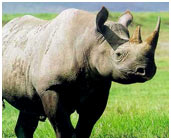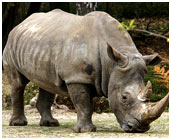The thick-skinned rhinoceros is virtually on the verge of extinction. Read interesting & amazing facts about the rhino.
Facts About Rhinoceros
The rhinoceros get their name for their horns, as in Greek, the word rhino means ‘nose’ and ceros means ‘horn’. The rhino horns are made of a substance called keratin which is found in human hair and fingernails. Rhinoceroses are universally recognized because of their massive bodies, stumpy legs and either one or two dermal horns. Though rhinos’ skin seems impenetrable and extremely thick, they are actually very sensitive to sun-burn and insect-bites. Rhinos protect themselves against blood-sucking insects by wallowing in the mud and letting them dry. But, this animal is most famous for the fact that it has got a very thick hide. Normally, it is referred to as ‘rhino’. Rhinos have been around on this planet for several centuries now. This fact is corroborated by their depiction in various ancient cave paintings around the world. Though rhinoceroses were widespread in early days, their numbers have come down drastically. Now, the rhinoceroses are limited to mostly national parks and reserves. Read this article to know the rhino better.

Fast Facts
Class: Mammalia
Order: Perissodactyla
Family: Rhinocerotidae
Species: Black Rhino (Diceros bicornis)
White Rhino (Ceratotherium simum)
Sumatran Rhino (Dicerorhinus sumatrensis)
Javan Rhino (Rhinoceros sondaicus)
Indian Rhino (Rhinoceros unicornis)
Habitat: Savannahs, Grasslands as well as tropical and subtropical forests.
Life Span: About 40 years in the wild.
Interesting & Amazing Information On Rhino
- The rhino’s horn grows all throughout its life.
- Hunters kill the rhino for their horns that are used in traditional Chinese medicine and are also used for ornamental purposes and are sold at very high prices in the black market.
- Rhinoceroses have a very bad vision, but an extremely good sense of smell.
- Rhinoceroses at times charge towards a distressing scent or sound when they feel threatened by it.
- In contrast to other rhinos, the Sumatran has a considerable amount of hair covering its skin.
- Rhinoceros are more active during nighttime and morning than the rest of the day.
- The rhino can sleep both standing as well as lying down.
- Though thick the rhino’s hide is actually sensitive, especially to sunburn and insect bites.
- When any calve is threatened by a predator, the adult rhinos usually make a circle around it giving protection.
- The rhinoceros can run at a speed of 30 to 40 miles per hour.
- The rhino can live four to five days in the absence of water.
- A group of rhinos is called crash.
- Rhinoceros are normally solitary creatures, but they sometimes form small groups.
- The white rhino happens to be most sociable.
- The black rhino has a pointed upper lip, whereas the white rhino has a squared lip.
- Three of the species of rhinoceros have been enlisted as endangered in IUCN Red List.
- The white rhinos can be divided into two sub-species namely, the southern white rhinoceros (Ceratotherium simum simum) and the northern white rhinoceros (Ceratotherium simum cottoni). As far as rhino sub-species are concerned, the southern white species of rhinos are the highest in number and most of them are found in South Africa. On the other hand, there are only four northern white rhinos left in the wild which is an endangered subspecies.
- The famous one-horned rhino is found in northeastern India and some parts of Nepal. The one-horned rhinos are found exclusively in certain protected areas in the Indian states of Assam, Gujarat and West Bengal. Apart from India these rhinos can also be seen in Nepal as well as Lal Suhanra National Park in Pakistan.
- A male rhinoceros is called a bull, a female is called a cow and a young rhino is called a calf.
- The Sumatran rhinoceros is the smallest in height. It reaches a shoulder height of about 1.4 m (4.6 ft) and weighs about 1,000 kg (2,200 lbs). The White rhinoceros is the biggest species which can reach a shoulder height of up to 4 m (13ft) and weighs more than 2,500 kg (5,500 lbs).
- The female rhino normally gives birth to one calf after a gestation period of about one and a half year. The calf stays with its mother till the next calf is born and this happens usually after two years.
- The rhinos are herbivores. They feed on grass, tender plants and other type of vegetation.


See also
More from iloveindia.com
- Home Remedies | Ayurveda | Vastu | Yoga | Feng Shui | Tattoos | Fitness | Garden | Nutrition | Parenting | Bikes | Cars | Baby Care | Indian Weddings | Festivals | Party ideas | Horoscope 2015 | Pets | Finance | Figures of Speech | Hotels in India : Delhi | Hyderabad | Chennai | Mumbai | Kolkata | Bangalore | Ahmedabad | Jaipur
- Contact Us Careers Disclaimer Privacy Policy Advertise With Us Lifestyle Sitemap Copyright iloveindia.com. All Rights Reserved.





